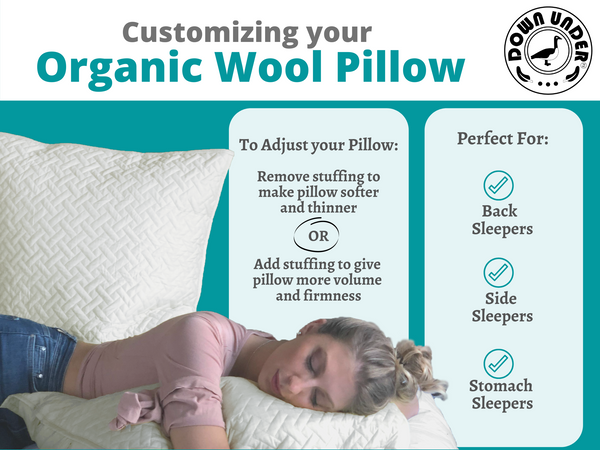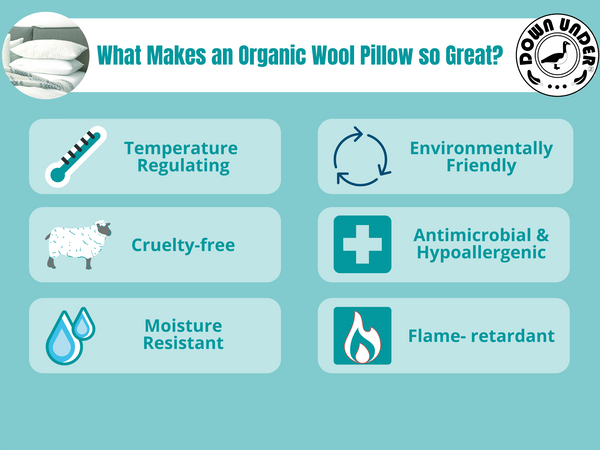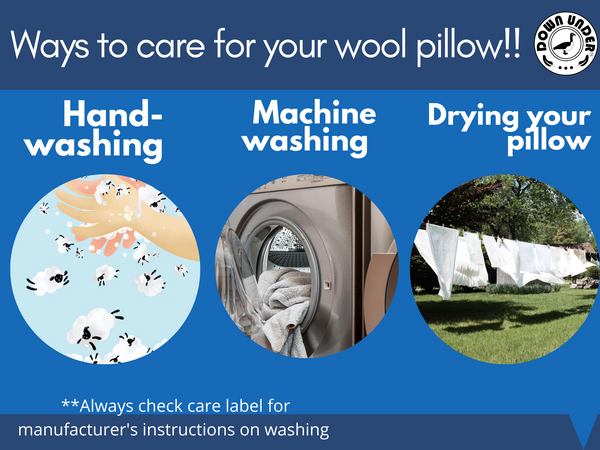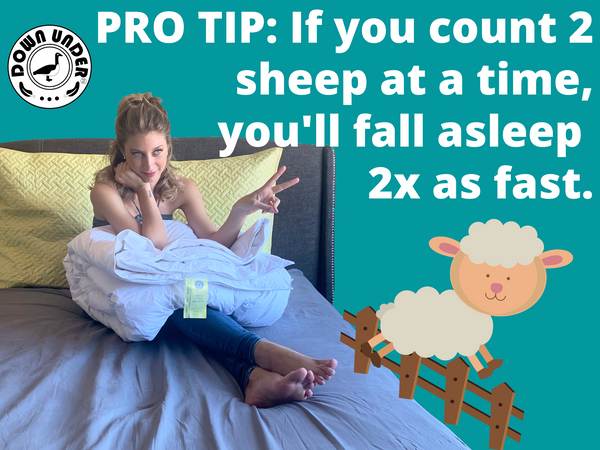We have been relying on sheep to sleep for ages. You know what I am talking about. What has anyone ever told you when you say you can’t sleep? ‘Count some sheep!’ Well, sheep are now being used in a new way to help you sleep, in the form of a pillow.
Sheep wool is being used as a filling for pillows, with some great results. You won’t even need to count sheep with the comfort of a wool pillow. Wool is already used for so many types of products, so why not for your pillow? This article takes you on the journey of why people are turning to a wool pillow instead of any other type of organic pillow. Sheep are truly like the insomnia swat team — keeping you away from the harm of no sleep.
Why Choose An Organic Pillow?
So first, what are the benefits of choosing an organic pillow? Let's review. Well other than the fact that going green is the general life choice you should ALWAYS be choosing… Organic pillows are made with 100% organic materials that are both good for you and good for the environment. Healthy and environmentally friendly. That’s a combo you can’t resist.
Do not hesitate to embrace your inner nature lover. Let’s save our planet! It’s important for the earth and for you!
What Is The Best Organic Pillow?
There are a bunch of different types of organic materials that your pillow can be filled with, the most popular kinds being Cotton, Down, and Wool. Most pillows that are organic come with a 100% cotton shell and 100% organic pillow stuffing.
The best part about organic materials is they do not put as much strain on our environment as synthetically produced materials do. These materials are also completely biodegradable and recyclable — so you can continue to reduce and reuse them! I love being green.
This makes organic pillows the healthiest choice on the market. Whether you like to shop from Costco or Casper for your pillows, make sure you select the best organic pillow you can find. Have a savvy rest while you can.

Why An Organic Wool Filled Pillow Is The Healthiest And Safest Choice?
Not only is this eco-friendly pillow made from organic materials, but it is done so without any harm to animals. Though wool is not vegan, it is still a material that does not put any cute fluffy sheep in harm's way! Shearing the sheep for their wool, typically done twice a year, is just giving the sheep a haircut, which in the summer months is necessary! Imagining the countryside and waking up on the farm after having a refreshing sleep! Just like me, sheep get way too hot in the summer time. I also get a haircut every summer just like the sheep to help keep me cool.
The most interesting fact about wool is that it regulates temperature. What does that mean? It can be both warming and cooling. I know, it seems impossible… How can something be both hot and cold? Well, let me explain. When your body is hotter, the wool is very breathable and prevents any excess sweating through the night, which helps keep you cooler. While on colder nights when your body temperature drops, wool can hold the heat and keep you warm. This organic wool pillow also helps you maintain a lower resting heart rate, ensuring you get a comfortable sleep throughout the night!
Wool lasts longer over time and is more durableand sustainable in comparison to cotton and down filled pillows. Wool has natural anti-microbial properties and is hypoallergenic. While fighting off bacteria, it also prevents mold and mildew growth within the pillow. Those who have severe allergies to down pillows might like the option of a wool filled pillow instead.
Wool is moisture resistant too, wicking away any moisture from the environment or our bodies. Another fun fact about wool is that it is also naturally flame retardant! How about that — comfy and functional! What is even better about wool pillows is that they are washable and washing machine friendly. No need to spend extensive money on getting your pillows dry-cleaned.

Are Wool Pillows Any Good?
How To Fluff Up A Wool Pillow And What Is The Best Sleeping Position!!
Wool pillows can be customized to your desired height and thickness. As seen with most of the top pillows on the market for 2020, adjustability is a huge desirability. Simply add or remove some wool stuffing to achieve the perfect comfort for you.
Best organic pillow for side sleepers……
Are you a side sleeper and prefer your pillow thicker and firmer? No problem! Just add some wool stuffing to the pillow. Or perhaps you are a stomach sleeper… We got you! You probably like a pillow that's thinner and softer. Just remove some pillow stuffing to achieve the pillow you want. And for you back sleepers out there — we know you like it somewhere in between, so you can play around with the stuffing as well until you achieve that perfect pillow!
It is important to remember that wool filled pillows will naturally compress approximately 30-40%, so having adjustability is a must if you want long-lasting comfort. Any stuffing you remove and are not using, you can store it in a plastic Ziploc bag. Our organic wool pillow is naturally sourced and made in Canada. Feels great to shop locally! If you shop on a popular place like amazon, here is our best selling Washable Wool Filled Pillow.
“I just found out it takes 5 sheep to make one wool sweater. I didn’t know they knew how to knit!” - CoolFunnyQuotes
What Is Better, Wool or Cotton??
Wool is a strong, flexible, and extremely durable material. Its fibers can bend 20,000 times before breaking, while cotton can only really withstand 3,000 bends before breaking. Wool is clearly the winner here. Because of wool's elasticity, it can hold its shape and last longer than cotton does.
Wool also has better insulation qualities than cotton. Remember those thermoregulation qualities we talked about? Well, against cotton it’s no exception. Wool traps and circulates the heat in air pockets, which help to keep you warmer than with a cotton filling, while also keeping you just as cool in the summer as cotton does. Whatever the temperature, wool adjusts. Ahh, the flexibility! I wish all things were that easy going…
Wool actually absorbs moisture too and helps to wick it away from the skin and our surroundings. This assists in keeping you warm and dry. Another great reason to check out Down Under Washable Organic Wool Pillow. If you are a sweatier sleeper, wool is a great option! Wool still has its insulating properties even when it is wet, which cannot be said for cotton. Once cotton gets wet, it becomes cold and uncomfortable. Ever get stuck in the rain wearing cotton? Then you know that cold and unpleasant feeling. Not only does wool have moisture management, but it also has antimicrobial properties. Keep those germs away!

Is Wool Better Than Down?
Wool, as mentioned before, is naturally thermoregulation. This means that if the weather is cold, wool will adjust to keep you warm, and when the temperature becomes hotter, the wool can in turn cool you down. This makes wool great for any kind of sleeper in any kind of weather. No season can outsmart this material! Though down is great at keeping people warm, it really does not accommodate those hotter days. It can be hard to cool down when using a down-filled product.
Wool can wick away sweat and other moisture to keep you feeling dry and comfortable while you sleep. It does not trap the moisture within like down does, but rather releases the moisture back into the atmosphere.
Down, because it traps the moisture within, actually creates a more humid sleeping environment. When down gets wet it tends to clump together which also affects the thermal properties of the product. The moisture getting trapped in down makes it the perfect environment for dust-mites and mold-spores.
Wool is hypoallergenic and antibacterial, which helps to avoid icky things from getting trapped inside. So much healthier! Down does not have hypoallergenic or antibacterial properties, which makes it terrible for those who do have allergies or are prone to getting sick. Down actually traps the dust and dirt within, keeping these unhealthy things inside your bedding. I know — I will never look at my down bedding the same way again, either! Want to know more about wool and down??
Take a look at our Wool vs. Down blog!
Products filled with down tend to require much more care when it comes to cleaning them. Wool filled products are generally machine and hand washable. Though they do require some added care to their wash cycle, they are much easier to care for than down-filled bedding and hold their quality longer even after being washed. The quality of the down filling can become impaired if the proper wash and care instructions are not followed. So finicky!
Wool is one of the most popular choices when it comes to bedding as it is a highly sustainable material that is naturally and rapidly renewable, recyclable, and can also be organically produced. Win-win!! Though down shares some of these same properties, it is not as sustainable as wool.
In regard to, animal welfare, wool, and the processes of producing it are much more humane than with down. As long as you are sure your wool comes from a reputable source, you can be more certain of humane practices. Down on the other hand is typically sourced from birds that are slaughtered for food purposes. More research and delegation are required to ensure the processes used to source the down are humane.

Care Tips For Your Wool Pillow…
Though these tips are generally universal for all wool pillows, please remember to ALWAYS read the care instructions. Ensure you are following the proper steps to care for your pillow. These are only guidelines and should be compared to your pillow's individualized care instructions first. So, have those ready, and follow along while I give you some useful tips on taking care of wool pillows.
The necessity of a pillow protector and pillowcase being used simultaneously is most apparent when it comes to actually keep the pillow itself clean. Because it is not the best to wash the pillow often, the covers protecting the pillow have to be easily washable.
That being said, wool pillows are technically washable. If you have to wash your pillow, remember to always use mild detergent or detergents that are meant specifically for wool-like Woolite. If you can, try to avoid washing the actual wool stuffing of the pillow. Remove the stuffing first and just wash the shell if possible.
If you feel you need to wash the entire pillow, it is best to leave the filling inside the pillow, making sure the shell is zipped up completely, so none of the stuffing falls out. You can either handwash or machine wash your pillow.
To Handwash
Fill the tub or sink with cold or lukewarm water. Add a minimal amount of mild detergent or specialized wool detergent into the water. You can also add a tablespoon of baking soda if there is any odor you are trying to eliminate.
Push down the pillow into the water until it becomes fully submerged and actually sinks to the bottom of the basin. Very gently swirl and squeeze the pillow. Do not rub together or agitate the pillow too much. Let it soak for approximately 15 minutes.
Drain out all the soapy water and refill with clean water. Swish around the pillow and squeeze out the soap. Repeat this rinsing process until the water is clear. Squeeze out the water from your pillow then wrap it in a dry towel to help squeeze out any excess water.
To Machine Wash
Fill the machine with cold or lukewarm water, then turn it off. Add a small amount of wool detergent or mild detergent to the water. Again, if you have any excess odor you are wanting to get rid of, you can add a tablespoon of baking soda. Submerge the pillow into the water, then add a bath towel to balance out the load. Put it on the gentlest cycle possible OR only use the rinse cycle and swish the pillow around using your hands to help wash the pillow, while also giving the pillow a chance to soak for at least 15 minutes. Get the best luxurious organic wool pillow here!
To Dry Your Pillow
It is likely best to remove the filling and just throw the shell in the dryer. Layout the filling on a flat surface in a well-ventilated area. If you have to dry the filling outside — remember to somehow secure it so that it does not blow away. You’ll have your neighbors thinking snow came early! I suggest one of those netted laundry bags or large pieces of cheesecloth. Wool can take up to 24 hours to dry. It is best to pull apart the larger clumps to allow for a faster drying process. Replace the filling back into the cotton shell once everything has dried. You can use a dryer to fluff your pillow, but only after the pillow is completely dry. Read on to find out how!
We all want that fluffy pillow. So, To keep your pillow fluffy, leave it out in the sun for a few hours on a dry day or pop your pillow into the dryer for 10 minutes with a couple of tennis or dryer balls on low heat or the “air only” setting. Try to fluff your pillows once a month to help prevent any sort of odor and keep your pillow looking and feeling newer.
Another way to fluff your wool pillow is by steaming it. This also helps to sanitize your pillow. You can use a designated fabric steamer or a large pot of boiling water with a steaming basket inside. Place handfuls of the wool filling into the steaming basket for no more than 2 minutes and then remove it. Repeat this process with all the wool fillings. Allow the wool to air dry, then replace the wool back into the shell. Voilà! So fresh! So clean!
Protect Your Pillow! Why A Pillow Cover Is Necessary…
So, there is a pillowcase, which is that soft fabric that goes on the surface of your pillow, and that you lay directly on top of. This we all know… But is this really the only and best protection for your pillow? It is not! I am here to tell you about a pillow cover, which is this nifty thing that goes between your pillowcase, and your actual pillow. That’s right, a whole extra layer of protection! Though pillowcases protect your pillow in some small ways, they are mostly for comfort and decorative purposes.
Pillow covers are also known as pillow protectors and actually assist in keeping away dust mites, stains, and moisture, and prevent wear and tear. No matter what kind of pillow you use, a pillow cover can come in handy. It helps keep your pillows cleaner, which means you do not need to wash them as often. When using pillowcases and pillow protectors together, you do not need to wash your pillow protector more than once a month either!
Do remember however to change the actual pillowcase you are laying on once a week to ensure proper hygiene and to make sure the pillow and pillow protector is also staying as clean as can be.
Pillow covers help to further prevent allergens from attaching themselves to your pillow. Not only does a pillow protector help keep your pillow intact and help it last longer, but it also keeps your pillow fluffy, preventing the heavy buildup of any excess body oil or dirt. Pillow covers can be made from a variety of materials, and generally come with easy, breezy zipper closure.
When buying your pillow protector, here are some things you might want to consider. You want the pillow cover to be the proper size. It should fit the pillow snugly without bunching up. The zipper closure should be easy to close fully without snagging the pillow. Pillow protectors generally come in standard, queen, king, and euro sizing. Always be sure to view the specific dimensions of the pillow protector and compare it to the pillow you are shopping for.
Pillow protectors come with a number of more specialized features; in case you are searching for something more specific. Some of these features include cooling, being waterproof, bed-bug resistance, and being hypoallergenic. Moreover, they come in several fabrics too. Try to find pillow covers that are made from organic materials such as bamboo, wool, or cotton to keep that healthy trend going!
You want a pillow protector that is easy to slip off the pillow and also one that is easy to wash. You want to avoid ending up with a cover that is harder to take care of than your actual pillow. Remember to always use protection! Pillow Protection, that is.










Leave a comment (all fields required)